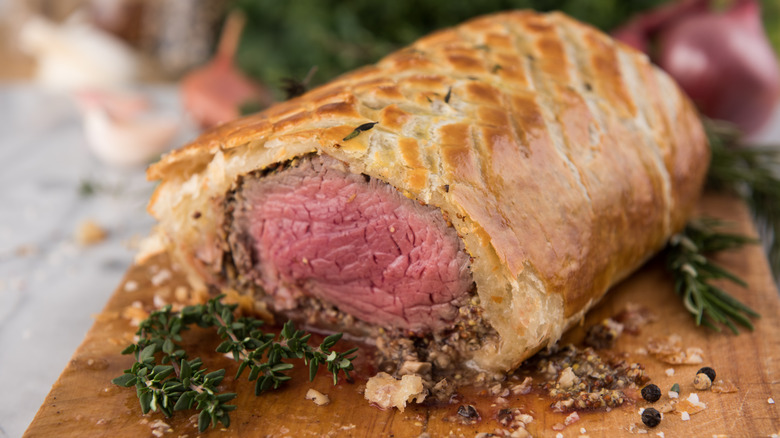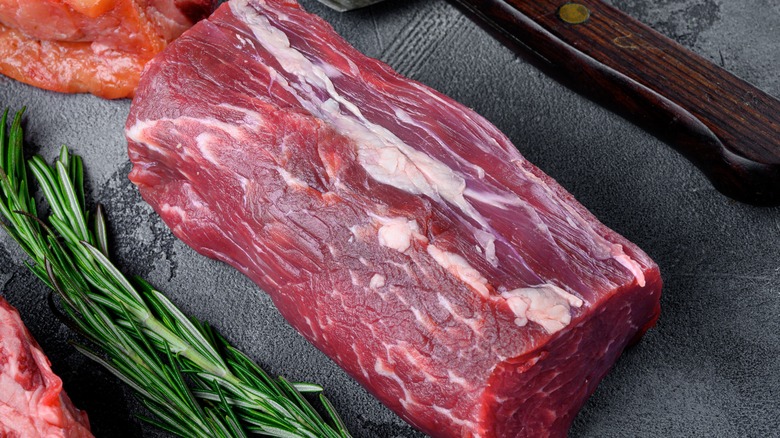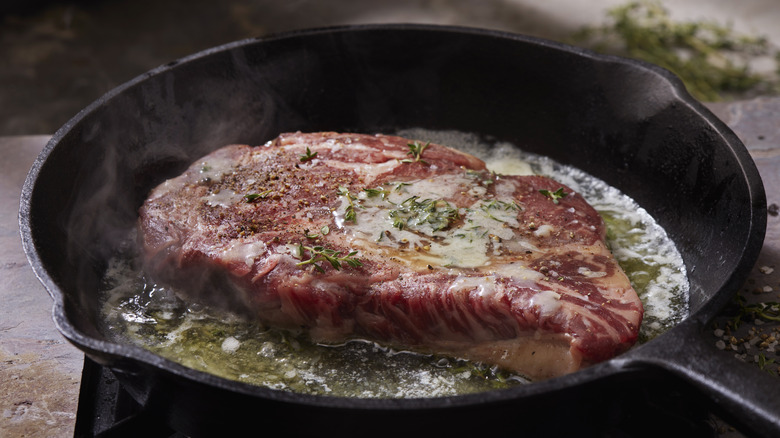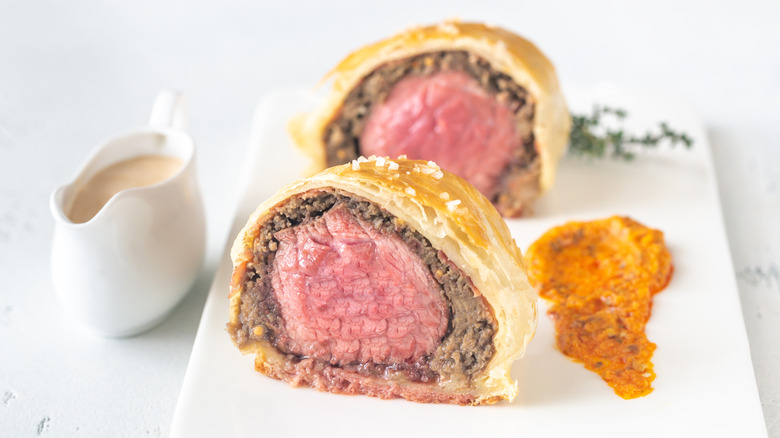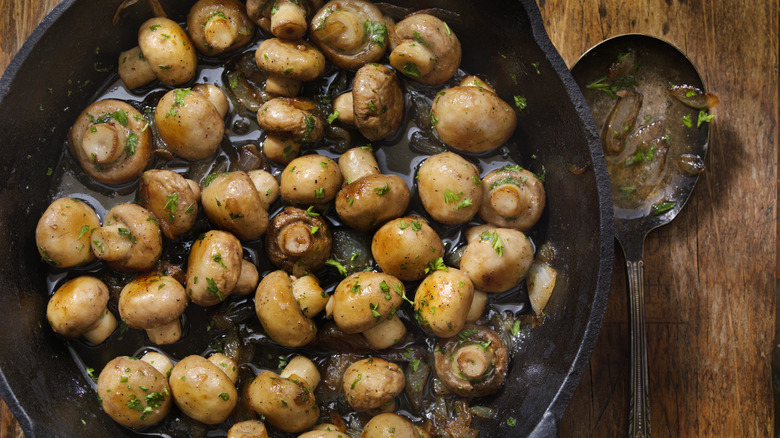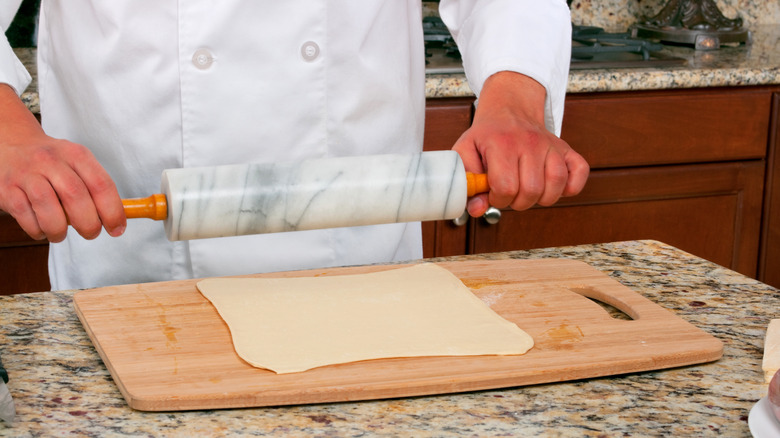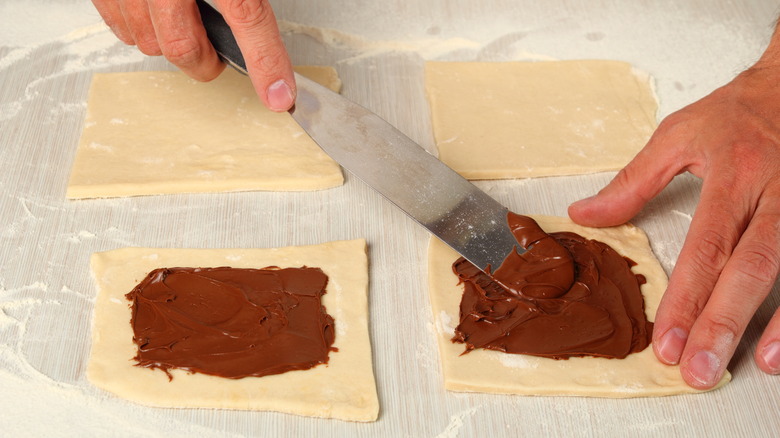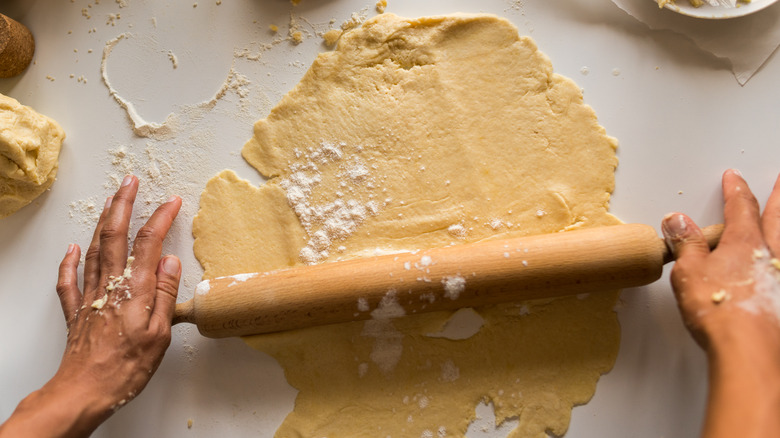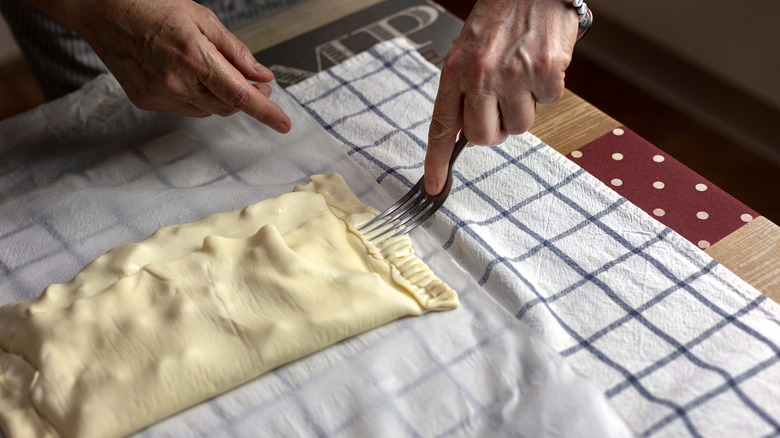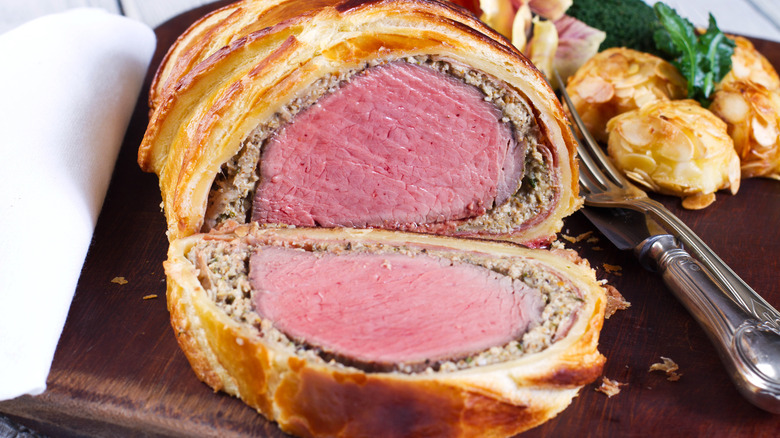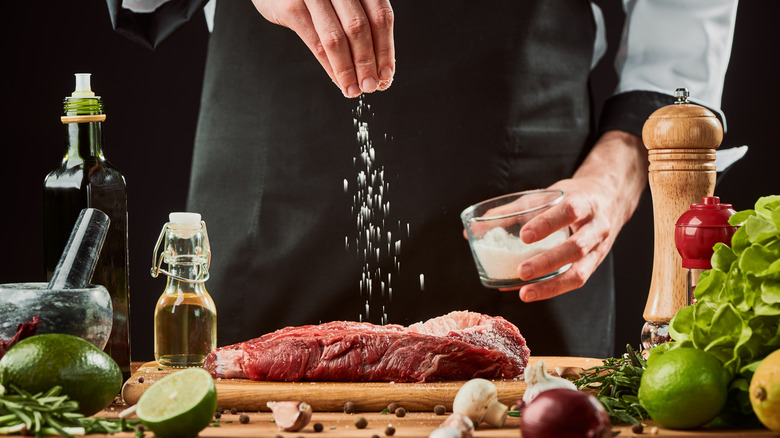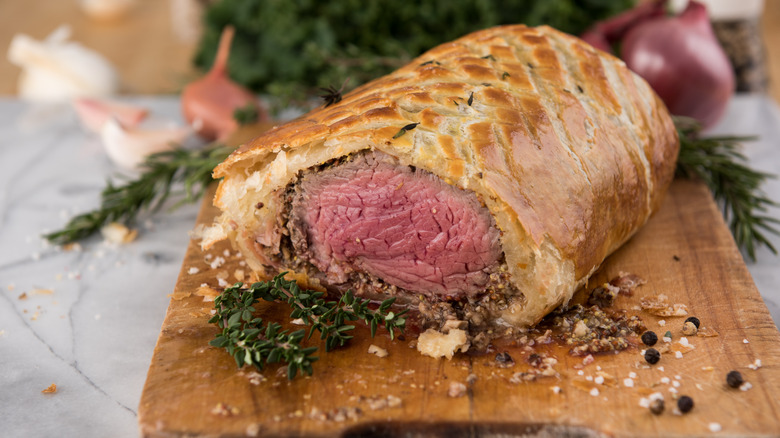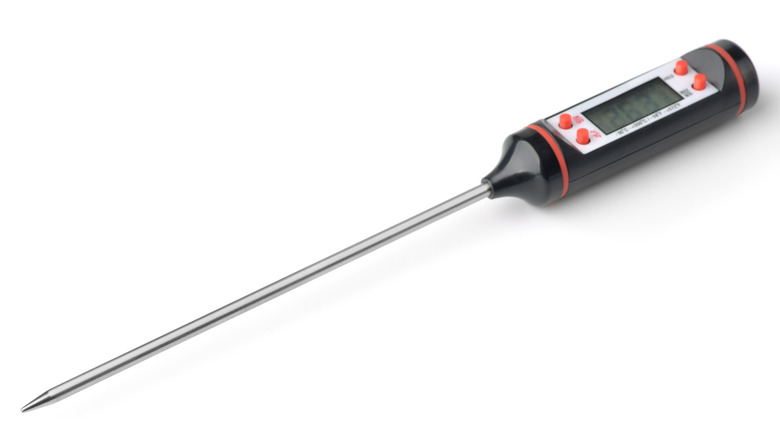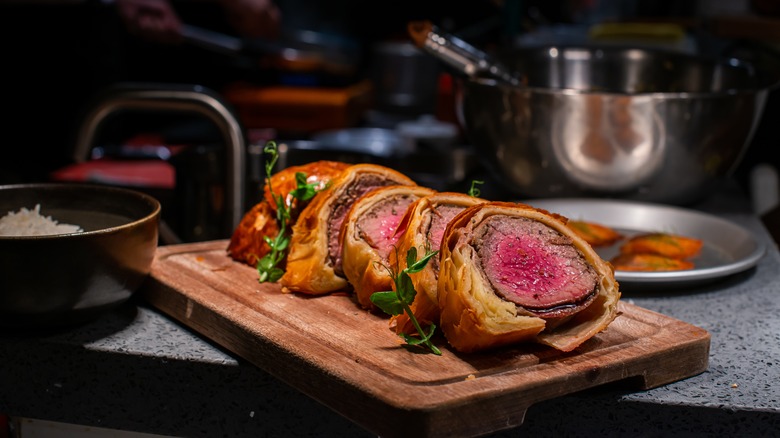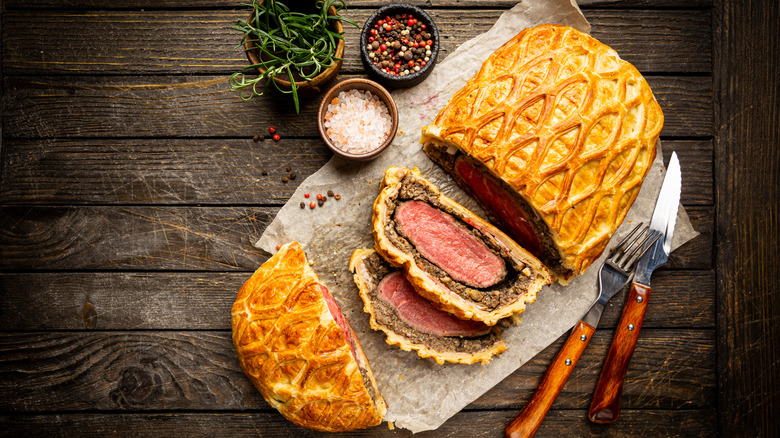15 Tips You Need To Master Beef Wellington
This classic, decadent dish, considered a staple of traditional English cuisine, was named after the first Duke of Wellington, though there's at least one theory that Beef Wellington was originally an import from France. Made with layers of prosciutto and a special mushroom mix lovingly wrapped around a juicy beef tenderloin, all bundled up together in puff pastry, Beef Wellington is a great dish to serve at dinner parties or on special occasions.
If you cook it well, it is incredibly moist and flavorful; however, as in any recipe that calls for a lot of steps, there are many ways for the preparation of this meal to go wrong. For cooks who have attempted to make this meal and found it came up short, not to worry, as you might just be missing a few hidden steps that can make all the difference.
From cooking techniques and seasoning tips to specific methods for making the all-important duxelles, we gave you our best secrets for making your Beef Wellington shine. Discover a few special tips and tricks that will take your dish from average to exceptional, and give your dinner guests a world-class restaurant experience right in your home.
Use fresh raw products and local ingredients
A well-made Beef Wellington sounds rich and delicious, but the quality of your raw materials makes a big impact on the dish's final taste. A lot of the flavor associated with a great Beef Wellington derives from picking high-quality ingredients, especially the beef, mushrooms, and puff pastry that form the core parts of the dish. You will want to get some good slices of prosciutto as well, but it's honestly harder to go wrong with prosciutto.
Pick a good cut of beef tenderloin, one of the leanest cuts of beef on the market, and try to find one that is preferably organic and locally sourced to ensure better quality. Though beef tenderloin tends to be less overtly flavorful than other cuts of meat due to its low-fat content, considering the strong flavors of the other ingredients in a Beef Wellington, it's preferred so the meat doesn't end up overpowering the dish.
The puff pastry is also incredibly important, as a bland or low-quality puff pastry will either result in a soggy Beef Wellington or overcooked pastry.
Sear the beef before you start wrapping it
You need to sear the cut of beef before you go through the wrapping process to put the prepared Beef Wellington in the oven. Cooks that skip this process may find a lot more of the beef's juices leaking out while the dish bakes, leeching into the puff pastry and making it soggy. This will usually result in a Beef Wellington dish that falls apart, not to mention a less flavorful and drier cut of beef.
A quick sear in the pan will ensure that the exterior of the beef gets a nice crisp on it, sealing in and retaining the juices through the cooking process. It will also lessen the amount of time you need to keep it in the oven. Cook it in the pan for a minute or two on each side, on medium-high heat. In order to infuse a little more flavor into the dish, you can put some extra aromatics on the beef here before you sear it, like rosemary, salt, and pepper.
Make the duxelles in the same pan as the meat
The meat may be seared, but that doesn't mean it's time to wipe out the pan just yet. For the next step, you're going to want to cook the duxelles in the juice and other remnants of the beef tenderloin, so it can take on some of that taste and tie in even better with the rest of the dish.
After meat is seared, the brown residue that remains at the bottom of the pan, called "fond", may not look that appealing but it has a ton of flavor in it. To make the duxelles, turn the stove up to medium heat with the fond in it, then very finely chop onions and mushrooms, mix them together, and toss them in the pan. If you have a food processor to combine these ingredients in, instead of chopping them by hand, that's even better.
Cook the mushrooms until they release all their liquid
Err on the side of over, rather than undercooking duxelles, when making the mixture. That's because the main ingredient of duxelles is mushrooms, which have a very high percentage of moisture. If they retain too much of it after being cooked in the pan, it will leak out onto the pastry. This will make it soggy and interfere with the carefully made layers of the Beef Wellington, as the pastry will likely break.
Leave the duxelles mixture in the pan for around eight to 10 minutes. You'll know the mushrooms are done when the liquid has evaporated and the mushrooms are starting to stick to the bottom of the pan a little bit.
One pro tip, if you're short on time when making your Beef Wellington: You can make your duxelles mixture in advance, cover it, and store it in the refrigerator, where it will last three to four days. When you're ready to make your dish, simply reheat it on low and proceed with the next steps in the recipe.
Moisten the cutting board before laying down
This is one small step that a lot of cooks miss, and it makes life a whole lot easier when trying to form and wrap all the layers of the Beef Wellington dish. Moisten the cutting board before you lay down the Saran or plastic wrap you will use to help you roll up the layers. Then continue to moisten the board before laying down each new layer of wrap.
Moistening the wood helps the plastic wrap stick to the cutting board, so it won't budge while you're preparing the layers. Then you can put down the puff pastry, layer the prosciutto on top, spread the duxelles mix, and put the beef tenderloin in the center of the mix without making a mess. However, be sure not to use too much water, just a touch. You don't want a lot of moisture transferring onto your layers and making them wet and soggy.
Leave a one inch border before you spread the duxelles
Before you spread your duxelles out on top of the prosciutto layer, make sure to leave a small border all around it. This will help ensure that when you put the beef on top of the duxelles and then wrap it up, the mushroom mixture won't squelch out the side. It's also recommended to use a spatula to spread the mixture, so it will end up relatively even, creating a nice thin layer.
However, you want to make sure the border isn't too big, which will result in the duxelles not being evenly spread throughout the inside of the Beef Wellington and a possible break in the layer when the dish is all wrapped up. Most chefs recommend leaving around an inch of space on the top, bottom, and sides of the spread-on duxelles mix for optimal layering.
Keep the pastry dough thin
Lightly flour the surface before rolling the puff pastry out, and try not to roll too hard — or preferably at all — over the edges of the dough, which will affect how evenly it ends up being cooked. If the shape is too uneven, you can even use a small knife to cut off any thinner edges and make sure the puff pastry is relatively uniform throughout.
In addition to having good quality puff pastry, when you're rolling it out on the cutting board, you want to make sure you keep the pastry dough relatively thin. This will help ensure that the pastry dough gets cooked all the way through without overcooking the meat that's inside. There should still be enough to form a nice, tight wrap around the various layers of the Beef Wellington, so there's no resulting breakage in the dough and seepage of the ingredients outside the dish while it's cooking in the oven.
Seal the excess pastry around the beef
Sometimes, even if you cut off the thin edges of the rolled out dough, you might still have excess pastry at the ends of the beef after wrapping it. Not to worry, as it's actually better this way, rather than having too little dough and not being able to stretch it to cover all those layers.
When you roll out the beef tenderloin in the middle, make sure to seal the excess pastry around it very well. One option is to use a fork to meld the edges together. This will keep any juices that are released from the beef while it's cooking in the oven inside the pastry. However, if there is too much dough left, more than the short edges a fork can push down, you may want to cut the extra pastry off. Those who cook at home frequently can keep these pastry pieces and use them in the future for another dish.
Wrap your beef tightly
Leaving too much air between your puff pastry wrap, the layers of mushrooms and prosciutto, and the beef, may result in the beef losing its shape and a less put together dish coming out of the oven. It's alright to have a little bit of space, as wrapping the layers too tightly, especially the dough on the outside, can result in no room for the puff pastry to expand, but overall, it's best you wrap your beef up tightly.
When the beef is almost fully wrapped, brush some egg wash over one side of the dough before sealing the two sides together completely. This will help the exterior layer stay intact. Make sure you place the Beef Wellington with the "seam" side down on the tray, and brush the whole thing with egg wash before putting it in the oven. If you'd rather have a clear sheen on the Beef Wellington, rather than the yellowish color a classic egg wash produces, you can use just egg whites for your egg wash.
Freeze and rest the meat in between each stage of wrapping
Since this dish takes a fair amount of time to make, many cooks disregard rest times, but these are incredibly important for cooking the meat well and making sure the different layers come together. To make a great Beef Wellington, a lot of cooks recommend you let the beef rest in the fridge or freezer while you are making the other layers. Resting the beef in this cold environment helps firm it up so it can be wrapped up more easily.
The only time you want to make sure your beef is resting outside the fridge during the cooking process is before you even sear it. That is because frozen or cold beef does not sear as well. Ideally, you should take it out of the fridge at least 30 minutes before you place it in the pan so it can be at room temperature.
Add a sprinkle of salt before placing your dish in the oven
Sprinkle the top of a Beef Wellington with salt after applying the egg wash. This will add a lovely touch of flavor to the dish, but it also serves a second purpose. A big sprinkle of salt over the prepared dish will also help maintain some crispiness in the dough while it's being cooked. Just make sure to add it on after you've brushed the layer of egg wash on the outside of your dish.
Most cooks also add pepper to give their Beef Wellington that slight bit of extra spice. Of course, depending on your own tastes and preferences, you can also add your choice of extra aromatics to add another dimension to the final meal. However, try not to add too many at one time. The flavors of a Beef Wellington are rich enough, and the aromatics preferably shouldn't overpower the dish with strong spices and additional flavors.
Add a little bit of thyme to your seasoning
In addition to the salt and pepper, you will use to season your beef before searing and cooking it, place a bit of thyme around the Beef Wellington on the baking tray for some extra flavor. You can also add thyme on top of the Beef Wellington before you bake it. Some people choose to incorporate thyme from the very beginning of the preparation process, putting it in the pan alongside the beef tenderloin while they sear it.
Make sure to use your sprigs of thyme while they are still fresh and green before any brown spots start to appear on the leaves. These sprigs will help give an earthy, herbal, savory taste to your dish, with a little hint of mint. Some cooks remove the thyme before serving, while others arrange a couple of fresh sprigs around the Beef Wellington for presentation purposes.
Use an instant read thermometer
Experienced chefs love to eyeball things in the kitchen rather than use measuring cups or specific tools, both when it comes to measuring ingredients and checking when a dish is done. However, for Beef Wellington, you're definitely going to want to use an instant-read thermometer, as all the layers covering the beef will otherwise make it really hard to tell when your tenderloin has finished cooking.
Insert your instant-read thermometer into the beef, and when it registers a temperature of 125 F, the meat is done. Although cooking times may vary, the meat will usually need to be cooked for anywhere between 35 to 45 minutes in order to reach this temperature. This will result in medium-rare beef; if you prefer your meat cooked a little more, leave it in for longer. A medium steak will register a temperature of 135 to 145 F.
Let the meat rest for 10 minutes before serving
It's tempting to want to bite into the Beef Wellington dish as soon as it's out of the oven. You can smell the cooked pastry, beef, and mushrooms. However, since you've probably spent a fair amount of time making this dish, it's a shame to let a little impatience ruin the final product.
Always let the meat rest for at least 10 minutes before serving; if you have the patience, you can wait up to 20 minutes. This gives the beef time to reabsorb its juices so they won't leak out immediately when you cut into it, taking a lot of the tenderness and flavor of the meat along with them. This is because the muscle fibers hold on to the liquids inside the meat better when the beef has had a chance to cool down a bit from the searing hot temperature it has when it's fresh out of the oven.
Cut the slices around an inch thick
Acclaimed UK chef Gordon Ramsay recommends cutting the slices around an inch thick, for both optimal serving and eating size. Though you might have different preferences for slice thickness when dealing with other types of meat, when it comes to Beef Wellington, very thin slices are prone to falling apart, and very thick slices will be too filling and lose the delicate look and feel of a Beef Wellington.
When you cut the dish into slices in order to serve it, make sure you use a sharp, serrated knife that will cut through both the pastry and the layers without causing too much damage to either, causing the dish to fall apart, and make nice, clean pieces. Ideally, if the Beef Wellington has been wrapped tightly and the puff pastry layer is thin enough, everything should be cooked through and the meal should retain its shape.
